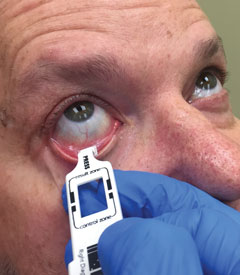 |
| In-office testing of MMP-9 levels can aid management of ocular surface disease. Photo: Chris Lievens, OD. |
A central element in maintaining homeostasis of the ocular surface and controlling ocular immune responses is the health of the corneal nerves. When the densely innervated cornea becomes damaged, it may result in decreased sensitivity and eventually neurotrophic keratitis (NK), which in turn alters immune cell activity, corneal nerve density and cytokine levels in both eyes, not only the affected one.
One way to examine the bilateral changes associated with an immune reaction after unilateral corneal damage is by observing changes in matrix metalloproteinase-9 (MMP-9) expression in the tear film, which is triggered by an accelerated tear evaporation cycle due to corneal denervation and other processes. A recent study compared 24 control eyes from 24 subjects with normal corneal sensitivity with a group of 25 subjects with unilateral NK and used a point-of-care immunoassay MMP-9 kit to determine MMP-9 levels in tears. They found that corneal nerve damage is not only linked to increased MMP-9 expression in both eyes but also may present a risk of meibomian gland dysfunction (MGD).
The patients with unilateral NK had significantly increased bilateral MMP-9 expression in the tear film compared with controls. Increased expression of MMP-9 in tears positively correlated with meibum quality grades in contralateral eyes, which the researchers noted could be explained in a number of ways.
“It is known that MMP-9 contributes to terminal differentiation of keratinocyte for a role of keratinization,” the researchers wrote. “In this regard, the increased keratinized materials might appear in the turbid meibum, alter lipid profile of meibum and reduce quality of meibum. On the other hand, the main culprit of clinical features of NK in the affected eyes is a decrease of the corneal sensitivity itself, and the MMP-9 in tears is a byproduct. Multiple factors including tear deficiency, desiccating stress and inflammation might contribute to the occurrence and the determination of the severity of MGD in the affected eyes.”
Because of the complex pathogenesis of MGD, the association between MMP-9 expression and MGD severity may not be as strong as the data suggests. Another limitation of this study is the long period of time between the event that induced corneal nerve damage and the patient’s clinical assessment used in the analysis, with an average duration of 29.3 months and a maximum of 70 months. The fact that the corneal nerve damage took place so long before may have influenced measurements such as the MMP-9 levels in tears if inflammation was no longer active.
The authors concluded that the point-of-care immunoassay of tear MMP-9 is an excellent indicator for inflammation in dry eye disease, easy to use and “may help clinicians in determining the bilateral anti-inflammatory treatment to prevent MGD or the possible delayed corneal erosions in the opposite eye in patients with unilateral NK.” In conclusion, while unilateral corneal nerve damage can induce bilateral MMP-9 expression in both eyes, it’s also important to pay attention to signs of MGD in this patient population.
Chan V, Yong A, Azuara-Blanco A, et al. A systematic review of clinical practice guidelines for infectious and non-infectious conjunctivitis. Ophthalmic Epidemiol. August 29, 2021. [Epub ahead of print]. |

